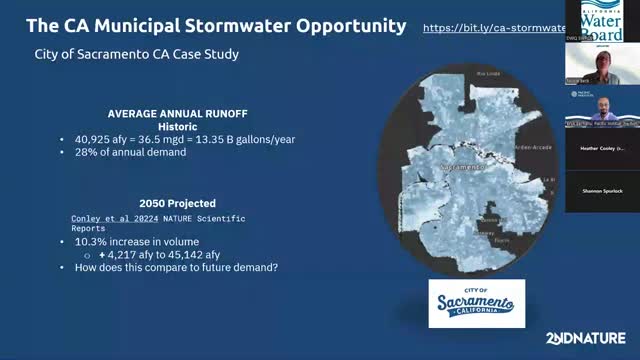Experts warn of stormwater crisis in Sacramento by 2050
September 15, 2024 | State Water Resources Control Board, Agencies under Office of the Governor, Executive, California
This article was created by AI summarizing key points discussed. AI makes mistakes, so for full details and context, please refer to the video of the full meeting. Please report any errors so we can fix them. Report an error »

In a recent government meeting, discussions centered on the evolving challenges of stormwater management in Sacramento, particularly in light of updated climate data and urban development patterns. Experts highlighted the significant potential for stormwater capture in the city, estimating that historical precipitation data indicates a volumetric potential of up to 40,000 acre-feet per year. This figure represents approximately 28% of Sacramento's annual water demand, underscoring the importance of effective stormwater management strategies.
The meeting also addressed the implications of climate change on stormwater runoff. Projections indicate that by 2050, Sacramento could see a 10% increase in stormwater runoff, translating to an additional 4,000 acre-feet per year. This increase is attributed to more intense short storms, which pose a risk of overwhelming existing infrastructure.
Participants noted the critical need for municipalities to adapt to these changes, particularly as urban areas become more impervious due to development. The discussion emphasized the necessity of integrating stormwater management into broader water conservation efforts, especially as California faces ongoing water scarcity challenges. Plans for conservation and demand reduction were mentioned as key strategies for the city to address future water needs while managing the impacts of increased runoff.
Overall, the meeting highlighted the intersection of climate science, urban planning, and water resource management as essential components in preparing for a more water-scarce future in California.
The meeting also addressed the implications of climate change on stormwater runoff. Projections indicate that by 2050, Sacramento could see a 10% increase in stormwater runoff, translating to an additional 4,000 acre-feet per year. This increase is attributed to more intense short storms, which pose a risk of overwhelming existing infrastructure.
Participants noted the critical need for municipalities to adapt to these changes, particularly as urban areas become more impervious due to development. The discussion emphasized the necessity of integrating stormwater management into broader water conservation efforts, especially as California faces ongoing water scarcity challenges. Plans for conservation and demand reduction were mentioned as key strategies for the city to address future water needs while managing the impacts of increased runoff.
Overall, the meeting highlighted the intersection of climate science, urban planning, and water resource management as essential components in preparing for a more water-scarce future in California.
View full meeting
This article is based on a recent meeting—watch the full video and explore the complete transcript for deeper insights into the discussion.
View full meeting
